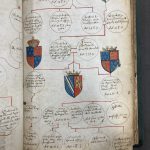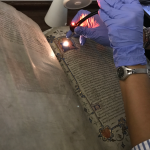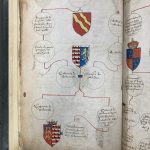Hidden Treasure Rediscovered
As part of the ongoing research project into the history, origins and manufacture of the Great Cowcher of the Duchy of Lancaster, teams at The National Archives have discovered a forgotten document created during the reign of Elizabeth I.
Researchers discovered the manuscript which details grants made by the Duchy before 1482 as part of the wider cataloguing project. Academics believe that the entries were copied, probably under the direction of Sir Thomas Heneage who served as Chancellor of the Duchy between 1590 and 1595, from the Duchy Charters and deeds held within the Tower of London during the Elizabethan age. It also includes a number of coloured medieval genealogies in the initial pages of the volume.
The register will now be formally processed and added to the Duchy records deposited with The National Archives, already one of the largest private archives in the country. The Great Cowcher which lies at its heart, is an illuminated register of evidences of title for the Duchy of Lancaster manors, estates and forests, containing some 2,433 documents written in medieval Latin and French. It is second only to the Domesday Book as a record of medieval landholding, and changing landscapes, and as a window into the lives of ordinary people and the experiences of different ethnic and religious communities under the Duchy’s governance.
The current research collaboration between the Duchy of Lancaster, University of Lancaster, Lincoln University and The National Archive aims to not only reveal the full content of the Great Cowcher for the first time, but is also using new scientific techniques to investigate its production and context. This latter involves advanced imaging and non-invasive analysis of the volumes’ constituent materials, including parchment, inks and pigments.
Commenting on the project, Dr Sean Cunningham, Head of Medieval Records at The National Archives, said: “This collaboration will allow us to make available the wide variety of records in the collection to a greater number of people. The collection contains original single-sheet charters with their visually stunning wax seals to more routine estate accounts. This will allow new discoveries to be made about the lives of ordinary people across England and parts of Wales over four centuries.”
Dr Lucia Pereira Pardo, Senior Conservation Scientist at The National Archives, added: “In recent years, the application of state-of-the-art scientific techniques to the analysis of pigments has shed unprecedented light on medieval manuscript illumination. This multi-disciplinary research project is an invaluable opportunity to reveal the secrets of the illuminators that created the lavish miniatures in the Great Cowcher Book and compare their practice with other medieval scriptoria across England and Europe.”
The research on the content of the Cowcher Books is expected to be completed by the end of this year.


